As an Amazon Associate Playpedalsteel.com earns from qualifying purchases. This page contains affiliate links.
The E9 neck is a marvelous tuning. Like the pedal steel, it contains loads of potential for expression, creative voicings, and evocative glissandos: basically it is just one of the coolest ways to play any type of music!
As players of this captivating instrument, we are no doubt aware of the potentials that lay beneath our hands each time we sit down behind this instrument.
But, with so many possibilities (add this to the fact/reality that this is one of the most challenging instruments to learn) it can be overwhelming and frustrating to try and tap into all of the potentials that we hope to discover and utilize.
However, there is hope! And one can find solutions to the E9 neck’s enigmas through a deeper study of it’s lower strings: strings 10 thru 6. Here are some helpful tips that can help a player utilize the potentials of the E9 neck…
Get to Know Strings 9 & 7 Better
Perhaps the most unfamiliar territory of the E9 neck lies in the chromatic strings. Ask yourself this, “What strings and areas do I know the best on the E9 neck, and feel most comfortable on?”
Most likely, you came to the conclusion that you know strings 10, 8, and 6-3 the best. Especially the abundant area of strings 6-3 that so many hot, classy licks can be found living.
Also, it is worth noting that all of the strings mentioned in your answer are part of the diatonic tuning of the neck: basically they are all notes found in the E major chord. Furthermore, we can observe that these strings are basically a guitar player’s Open E tuning (like what Duane Allman used and Derek Trucks uses).
It can be valuable to notice that if you came to pedal steel from a guitar background, then you have most likely been gravitating towards these strings because of their familiarity to the six-string guitar (particularly Strings 5 & 4). This is not a bad thing: you have been intuitively finding patterns of resemblance between the two instruments to catalyze your learning, which is very advantageous and beneficial.
However, a barrier emerges when you wish to achieve the freedom you had on the six-string. In terms of knowledge of scale positions, arpeggios, harmonic elements, and especially movement – it is certainly easier for most to play a sizzlin’ lick up/down/across the fretboard of a six-string guitar, than it is to play the same lick in similar motions on the E9 pedal steel.

Most likely the culprit of this barrier is any string that is chromatic on the E9 neck. These are Strings 9, 7, 2, and 1. Since we naturally have a better understanding of strings 10 and 8 (because of their relation to the diatonic open E chord of the tuning), our greatest obstacle to fluid movement through strings 10-3 (which is basically the whole neck/tuning!) becomes strings 9 and 7.
Because fluid movement through strings 10-3 covers so much of the neck, fretboard, and tuning, it can be beneficial to focus on these and then tackle strings 2 & 1 on another mission.
Here is an example of movement that can utilize Strings 10-6:
(One diagram displays the note names, the second displays the relative scale degree numbers for understanding/hearing how they relate to each other in context of the scale/key)
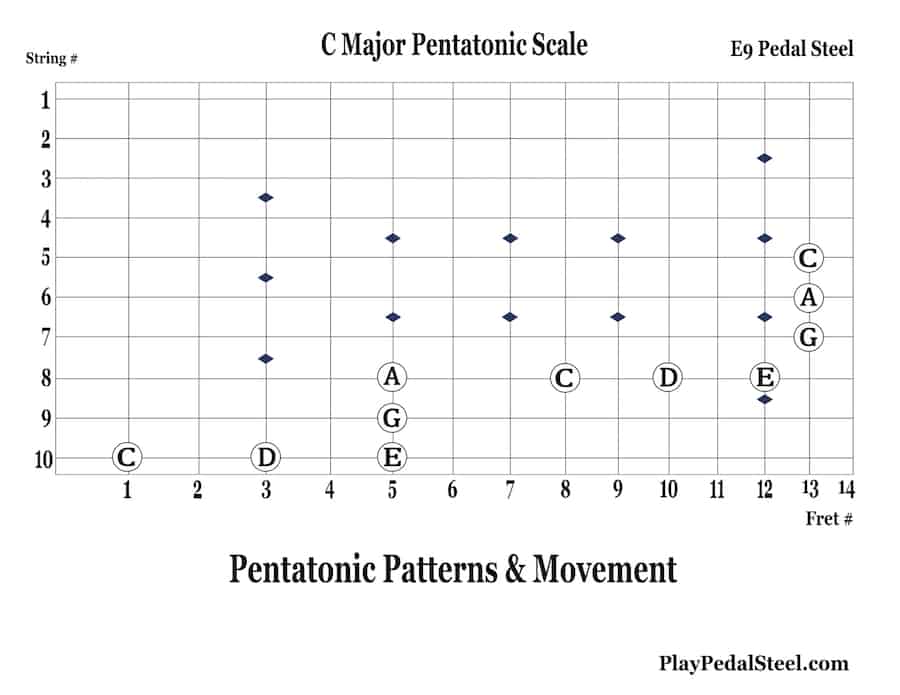
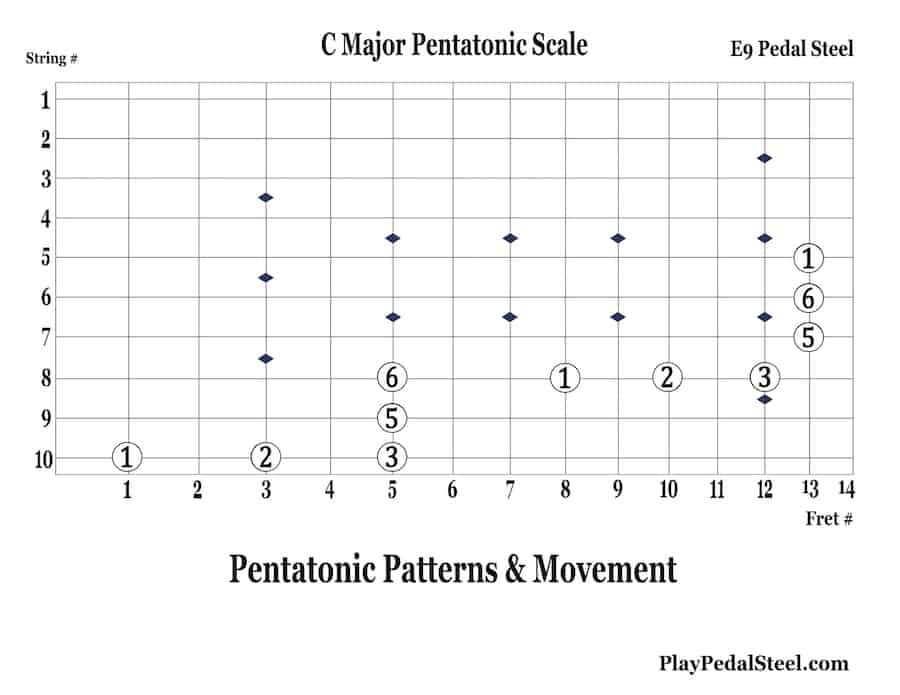
Ways To Get To Know Strings 9 & 7 Better
1. Practice Horizontal Movement on Just One String
- This means only playing notes found on that string by moving the bar to your left or right. Much like slide players do. Or to get a better picture, imagine if your pedal steel only had one string and no pedals (this would make the bar movement and horizontal directions basically your only way to express different notes).
- A good exercise to do this is by playing a C major scale, starting at the root, in a creative manner. Try not to play the major scale linearly up and down like a robot, instead create music or licks spontaneously – this can be done in context by playing over a song, a C drone, and/or a metronome.
I personally like doing this over a drone with a metronome beat going as well – this tightens up your rhythm, puts the major scale notes in context so you can understand the sound and implications of each note in the scale in reference to the key/chord/scale, improves your ability to improvise instead of just copying other player’s licks, and just makes practicing more fun and enjoyable, which is something every musician wants.
- When working on the major scale in this manner, it is very worthwhile and beneficial to try and understand the scale degrees of each note while you play them (i.e. C is 1, D is 2, E is 3, F is 4, G is 5, A is 6, and B is 7 [For the C Major Scale]).
This will allow you to know where these notes can be found in relation to other pockets and notes once you reenter navigating the whole fretboard and all the strings. For example, you now will know that a C note can be found at String 9 Fret 10, which will be helpful if you venture into this territory of the fretboard, especially if you are in the key of C.
Benefits
- Your bar control will improve immensely, and as a direct result, so will your expressive capabilities on the instrument.
- Your ability to see and navigate the fretboard will be positively influenced in a peripheral manner. Basically, it will help keep you from playing solely in vertical pockets. Buddy Emmons was a master of this type of peripheral/horizontal movement to traverse the fretboard and move with freedom to and from pockets, especially on the C6 neck.
- You will visually and intuitively notice the interval distances between each note of the major scale (i.e. there are only two half steps in the whole scale – another interesting one to get your mind rolling is that there are whole steps between scale degrees 4, 5, 6, and 7, which lays out nicely as consecutive two fret increments on the fretboard. This makes movement easier for a bit, until the next half step is approached.)
- When you bring the other strings back into the mix, your ability to move to and from them, and connect them to strings 9 & 7, will be more fluid and achievable because of not hitting as many roadblocks due to lack of understanding of these chromatic strings.
- You don’t have to practice this very long (and you probably won’t feel like it because of how quickly you bar hand/arm will tire from moving so much). Five minutes for String 9 and five minutes for String 7 is plenty to do once a day. If you do this once a day for a month, you’ll be amazed at how much less scary these strings can seem. Do this for a year and we hope you’ll send us a postcard from this nice destination that you have found yourself relaxing in!

Visual Diagrams That Display This Practice Strategy
All diagrams can be clicked on to enlarge, and feel free to print them out! Click on them again once attachment page opens to get full view…
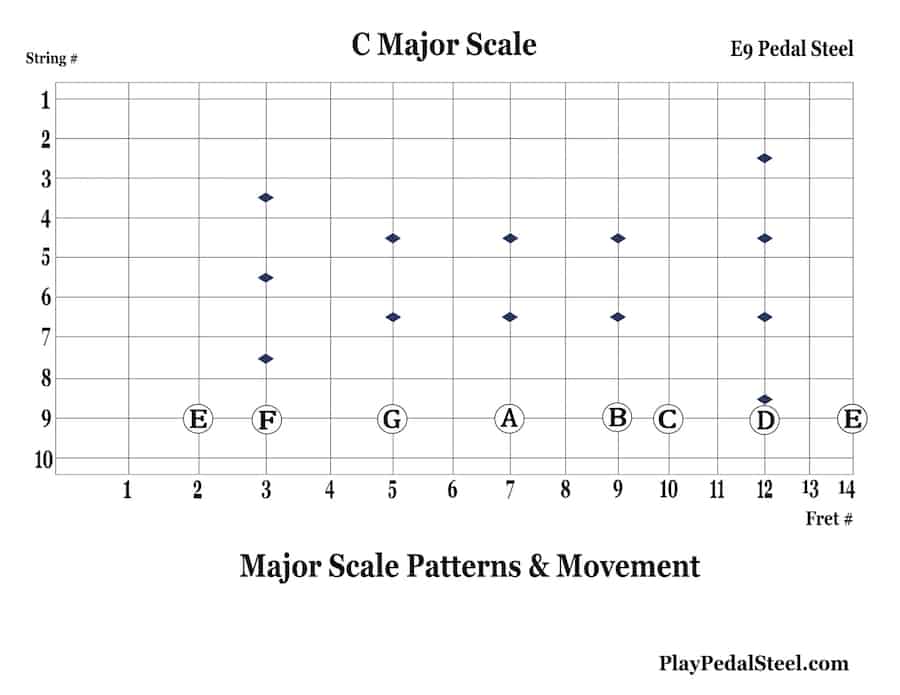
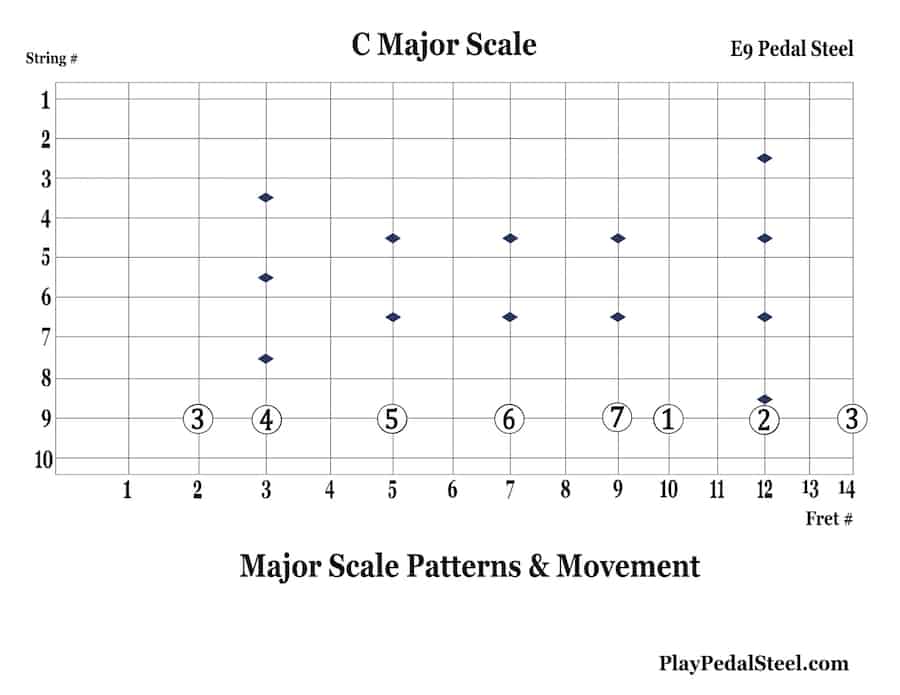
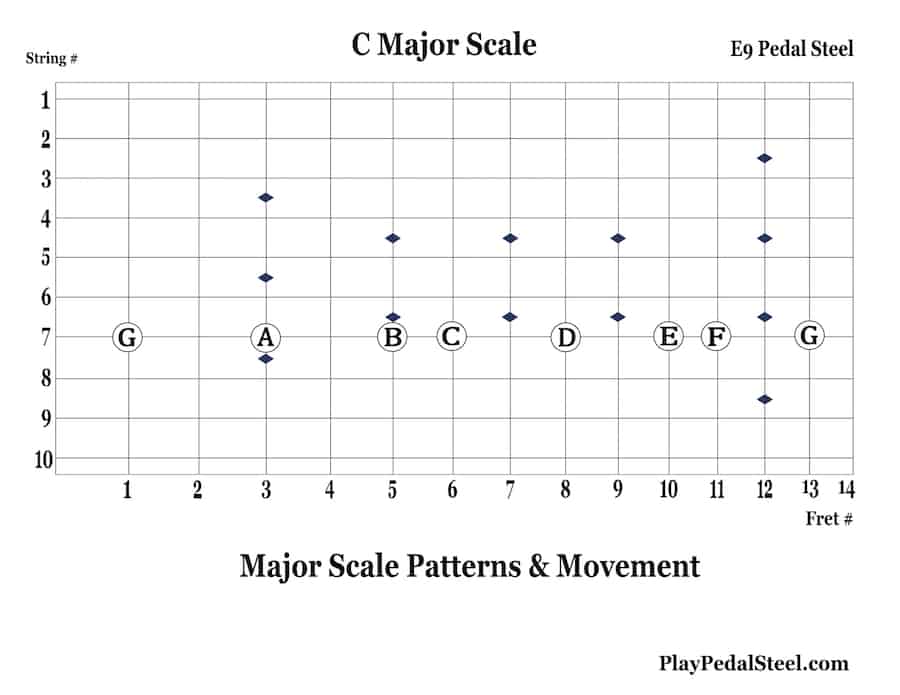
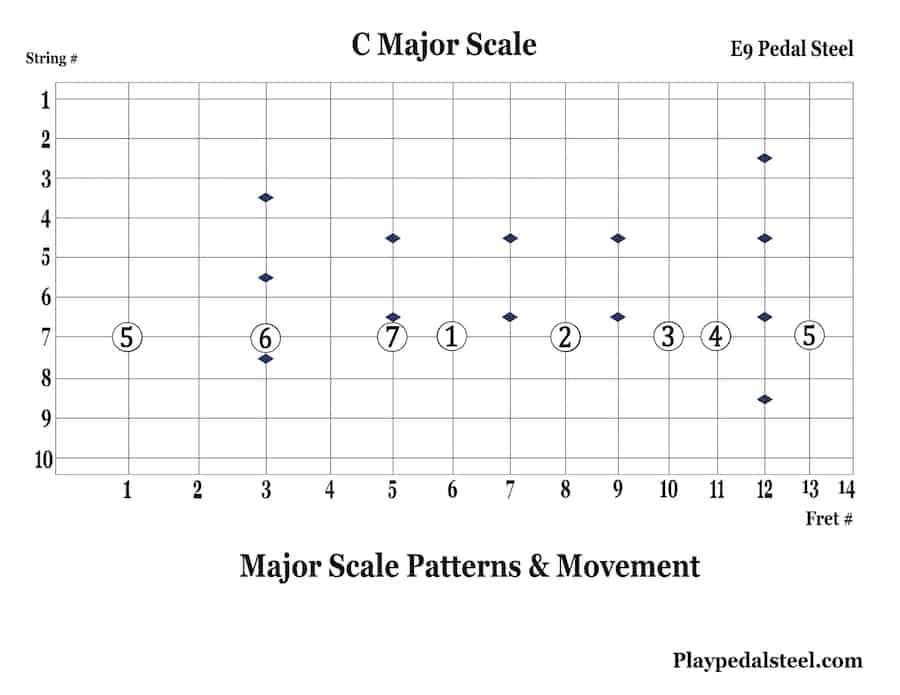
2. Practice and Learn the Vertical Pockets Associated with Strings 9 & 7
- This basically means finding the root note of our scale and locating it on String 9 or 7. Then learn the notes on the other strings above and below that string (notes that are close by without having to move the bar much (more than three frets usually “feels” outside of the pocket.)
Like mentioned in the previous strategy, try to attach scale degrees/numbers to the notes you are learning, so that they have context for your ear, brain, and so you can communicate better with other musicians on any instrument. I recommend doing this with the major scale to start, as there are so many other scales and possibilities that are inherent in just this one scale.
Benefits
- When combined with the horizontal exercise mentioned previously, as well as your previous knowledge of other main pockets and positions, you will really be able to see the fretboard light up beneath your eyes.
- You will find new ways of entering and leaving the pockets that you already knew well.
- You won’t have to rely on pedals and pedal licks as much to express yourself in the moment.
- Your right hand blocking technique will improve because of having to cross from string to string in each pocket.
- Your bar control will still improve.
- You will eventually feel just as comfortable with these pockets, as you do with the fundamental open pedal position and AB pedal down position.
- You will have much greater control and possibilities for playing single-string passages, which can sound amazing on pedal steel if done tastefully. Buddy Emmons was a monster at single-string passages, especially on the C6. Who would’ve thought we have similar capabilities of single-string expression on the E9 neck? Sure it may be more challenging, and not as intuitive from an interval stand point (strings 9-6 are all a whole step apart), but that doesn’t mean it’s not possible!
- If you practice this a little bit, consistently over time, we’d really be delighted if you could send us another postcard of this beautiful paradise you’ve traveled to.

Useful Examples & Diagrams of this Approach
String 9 Pocket for C Major Scale…
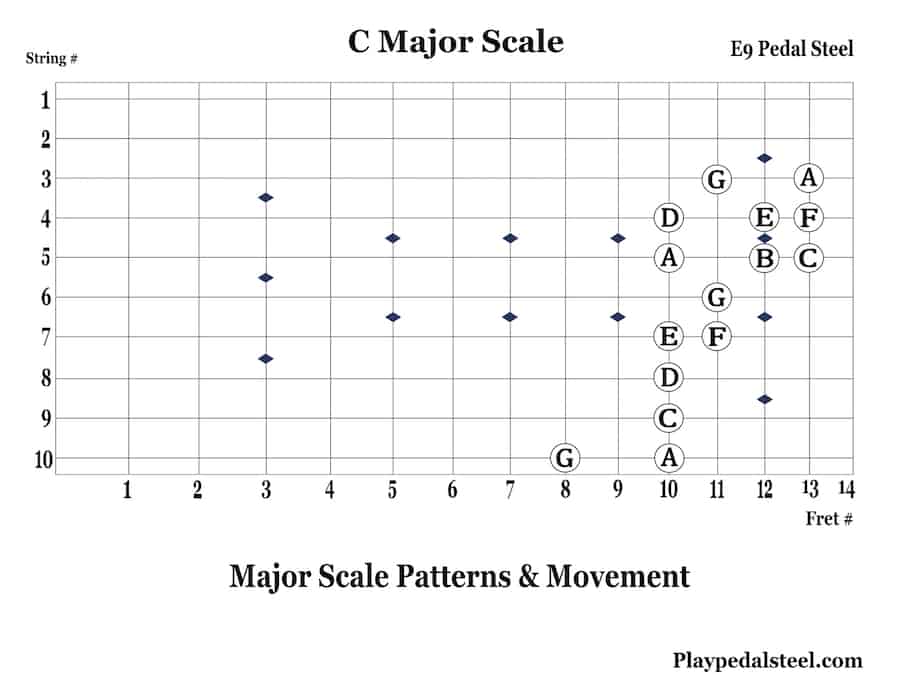
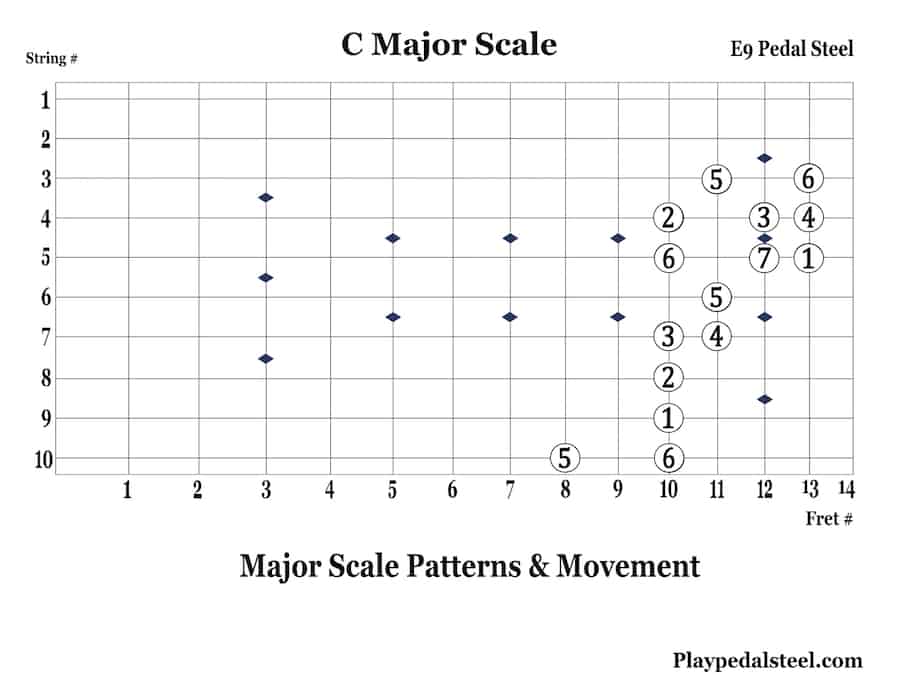
String 7 Pocket for C Major Scale…
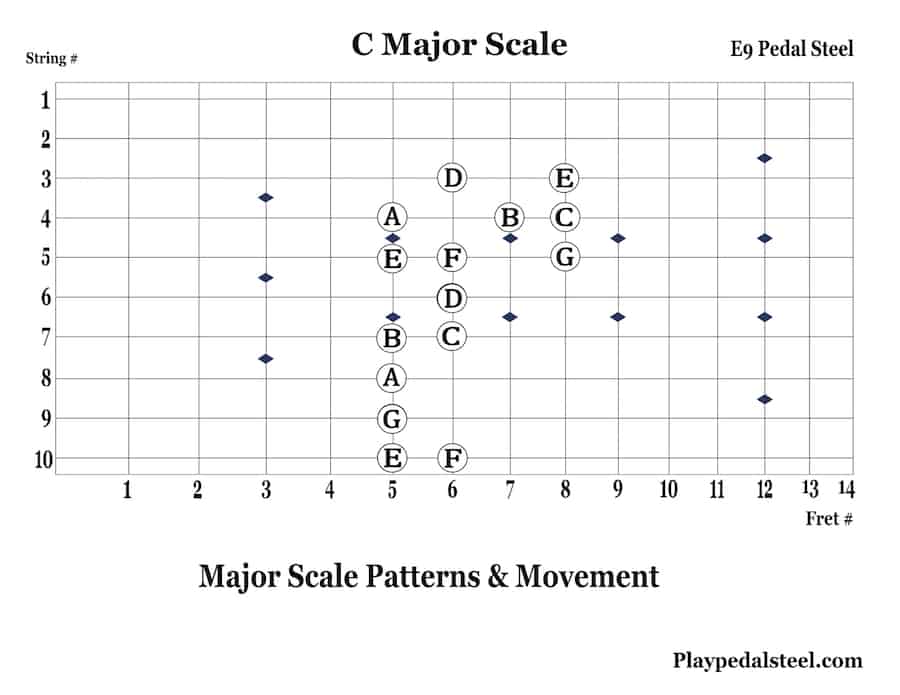
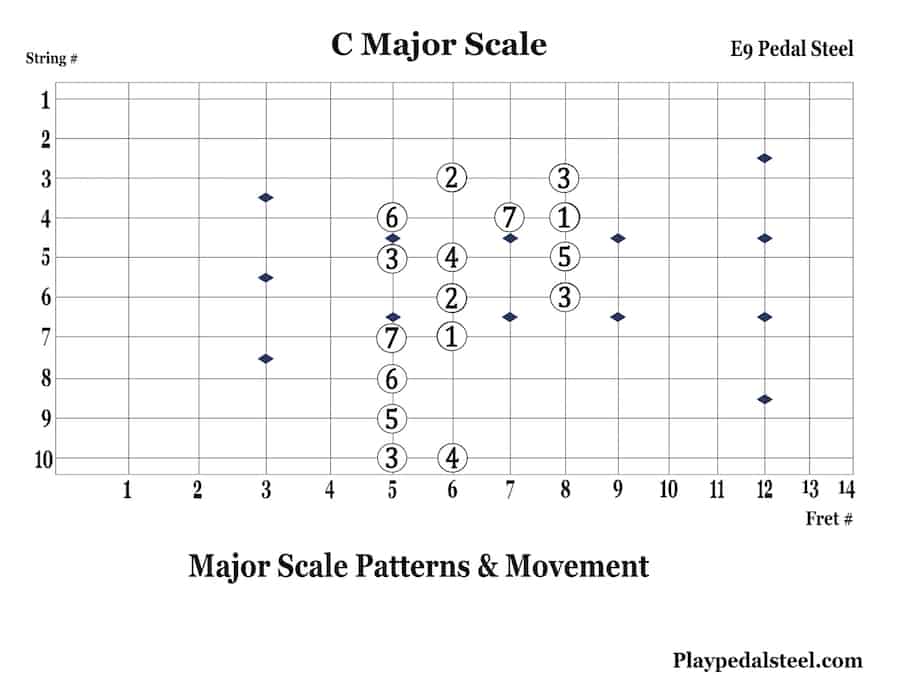
Nice To Have Options
One of the biggest benefits of utilizing Strings 9 & 7 is that it quickly becomes apparent that there are many directions to move on the E9 neck.
This means there can be more options to choose from; a player can gain freedom in instances where they may otherwise get stuck. It isn’t always easy to see or visualize these on the E9 neck, but they are there to be found.
Below are a couple of diagrams that help display movement possibilities that can easily go unnoticed…
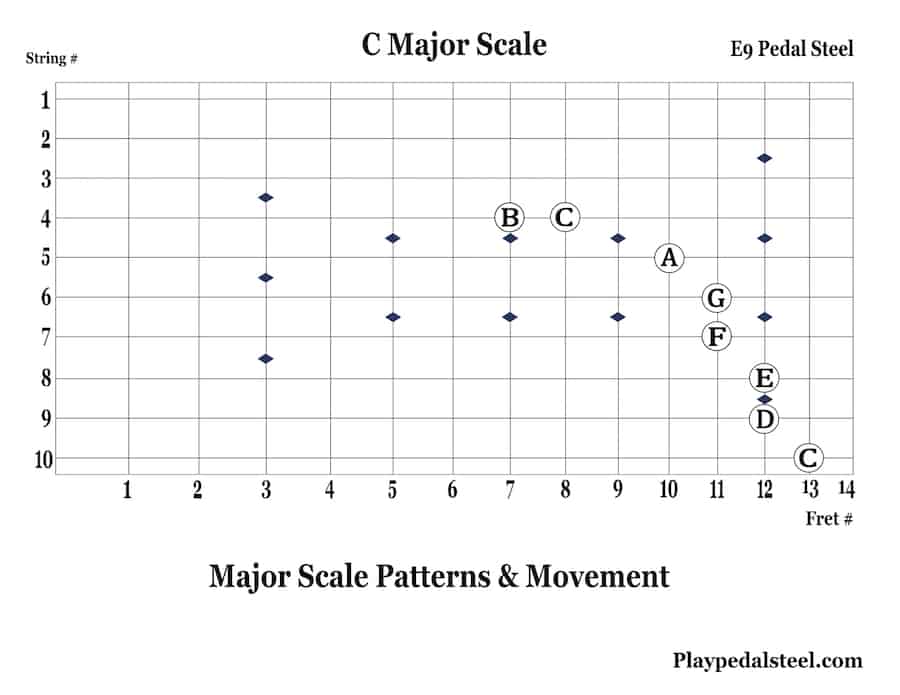
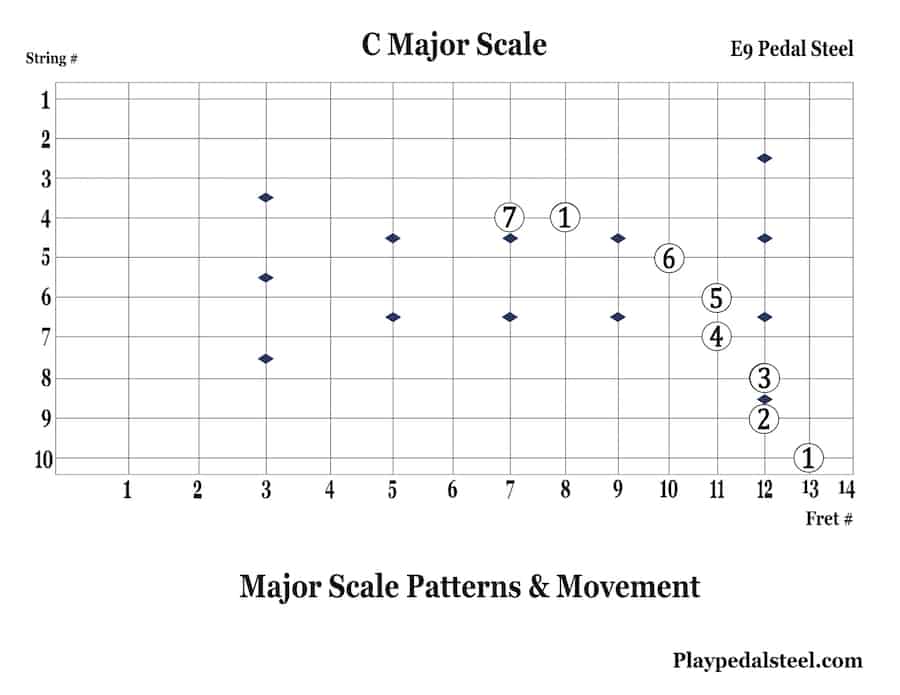
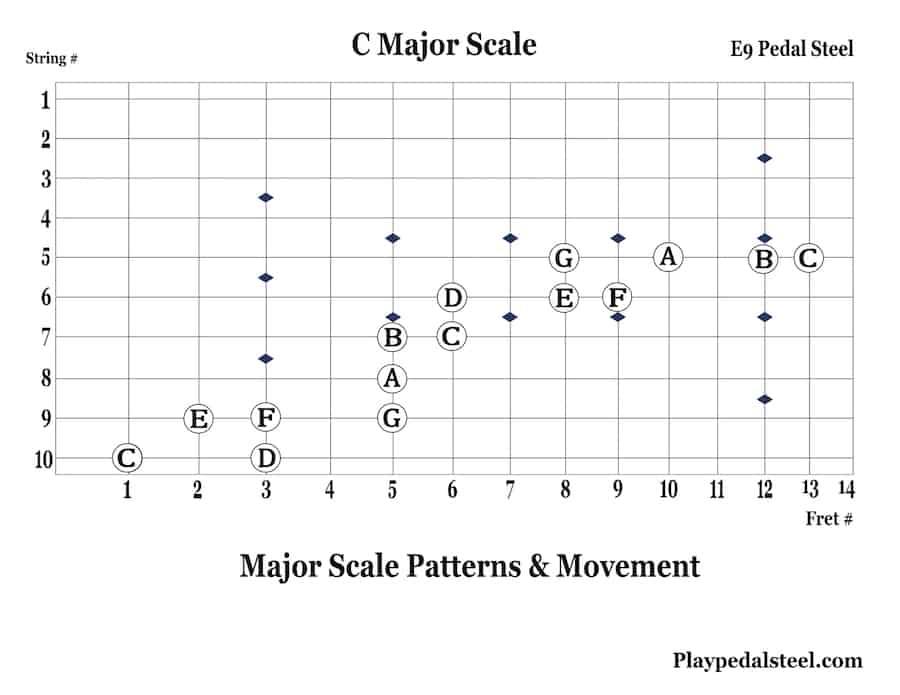
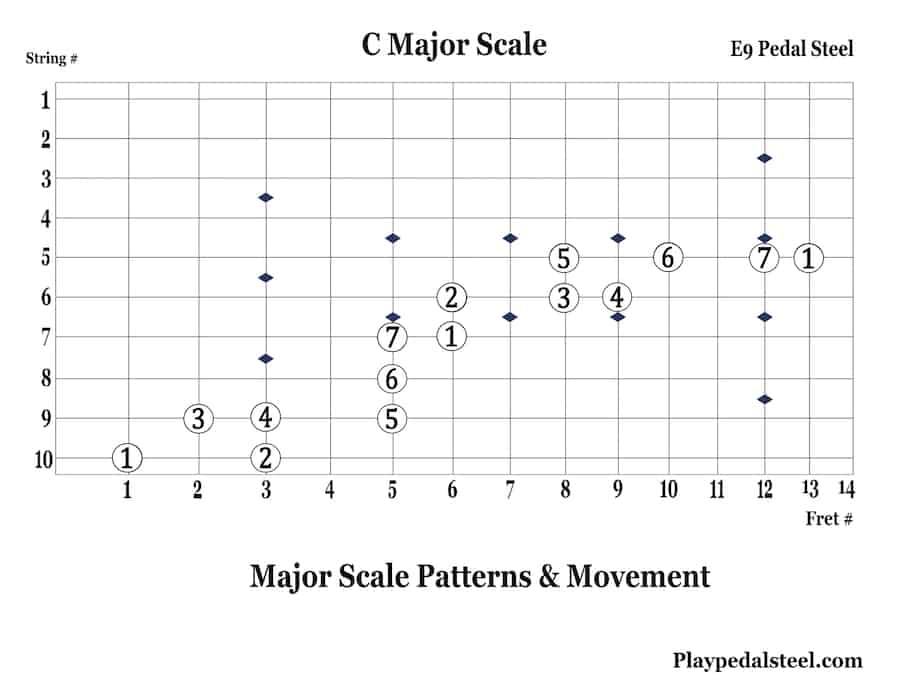
What About The Harmonized Thirds and Sixths We Love So Much?
They are still there, and they still want to be played. Now they will be even more impactful when they are heard, and they will seem even more familiar to you and comfortable than they did before.
These harmonized notes will be happy you spent some time away from them, because when you get back to them, you will have an even greater appreciation and respect for them than before.
Try to visualize and hear this in your mind: you are on the bandstand, or practicing at home for fun…
You play a nice, soulful pentatonic single note run that takes you through Strings 10-6, and just when you think you’ve run out of steam, you reach the Golden Land: Strings 6-3 that you’ve practiced much more than any other area, and you are free to unleash a powerful lick in harmonized sixths that you can find easily because of past seat time and practice.
This means your single note run through the swamps of Strings 10-6 just hopped onto the back of Strings 6-3 (licks you can already express freely) and as a team they double the length, power, and impact of your lick, with a nice interesting interplay of single notes combined with harmonized notes.
That sure did open up a lot of solo/lick/melodic capabilities in an interesting, enthralling way!
Here are a couple pentatonic runs that may lead to this powerful capability:
(Remember that once you arrive at Strings 6-3 with these patterns, you can add more to it by playing harmonized riffs you are already comfortable with. This extends the lick, opens new doors, and is interesting in its combined use of single notes and harmonized notes to express an idea.)
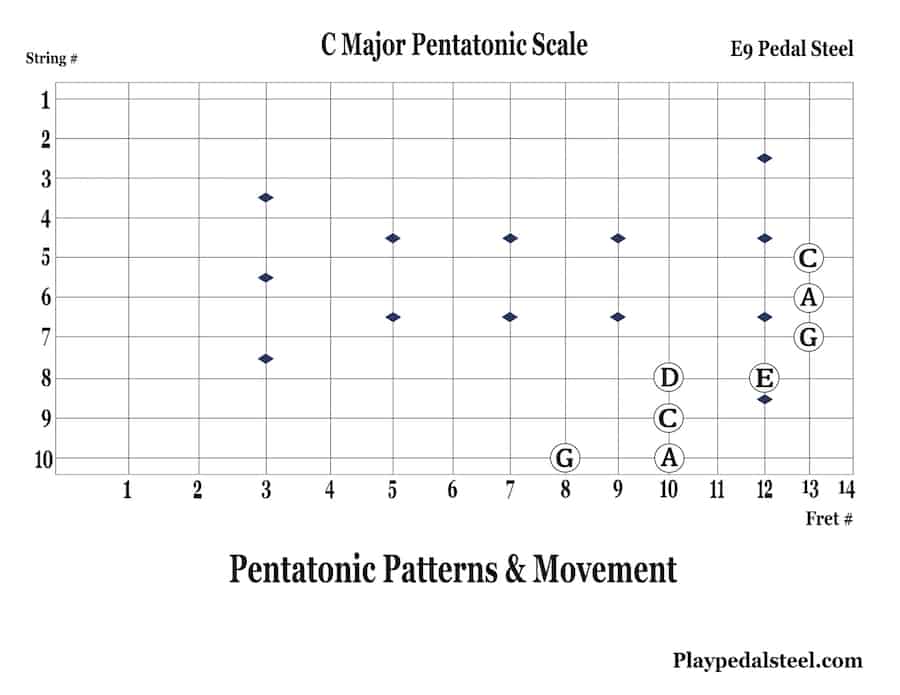
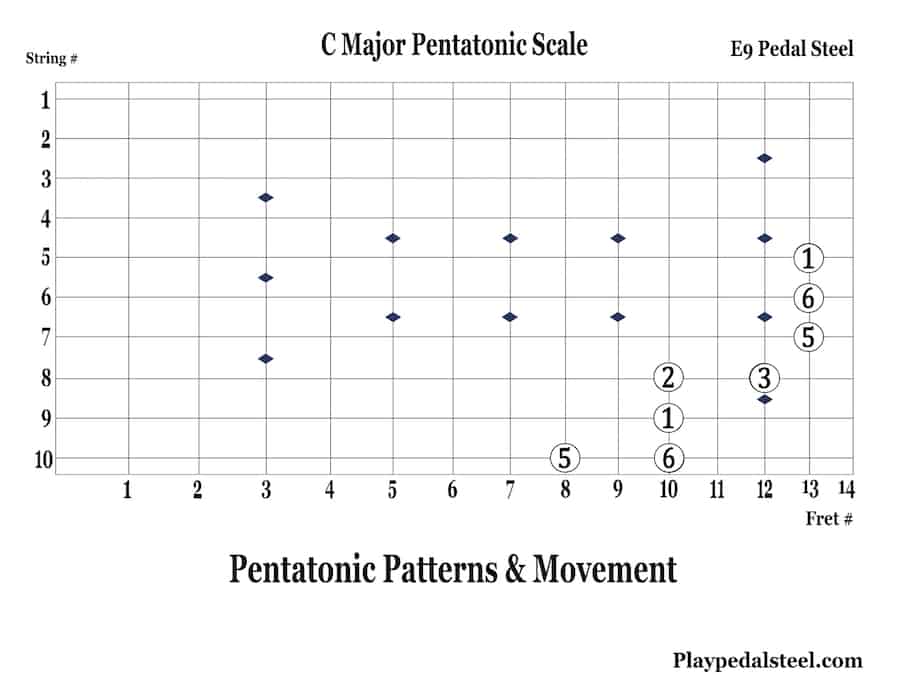
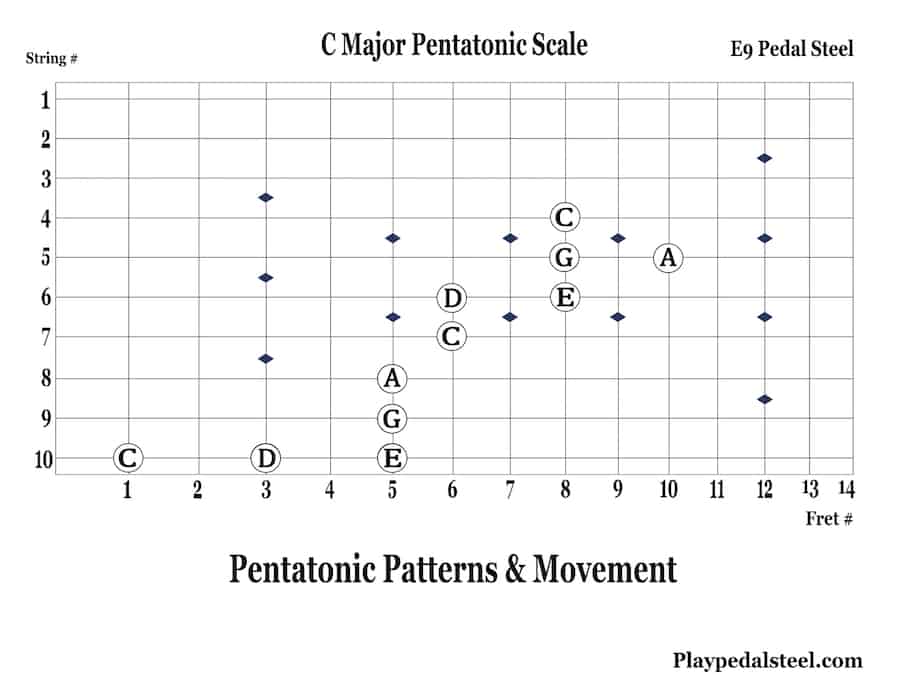
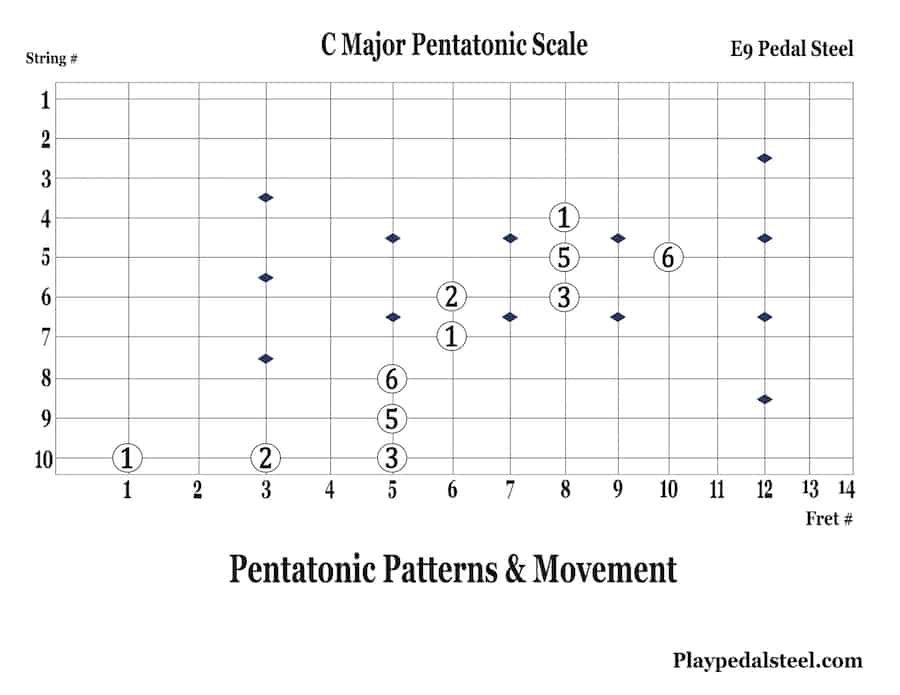
Positive Connections
So what are the implications of all this, and how does this benefit us as players?
Well, most of us are probably striving to feel calm, confident, centered, and in control when we play the pedal steel, whether on the bandstand or at home. We are probably looking for a freedom of expression, which we can more easily attain through skills that we practice on the instrument (and away from the instrument).

Remember the first time you played something that sounded cool on the pedal steel, a sound that was so beautiful and profound and unique that you couldn’t help but search for more of it?
We are all looking to find more moments of joy and inspiration like this, a warm feeling of acceptance: we probably have accepted the pedal steel into our life and home because of its intrigue; its attractive and sensational sounds.
Likewise, because we have accepted it in a warm and hospitable way, it too will accept us in this cordial way. Especially if we give it time, attention, and good intentions.
So remember, no matter how challenging and frustrating the pedal steel may seem at times, it is like a good friend: gracious, warmhearted, and always glad to see us whether a day has passed or twenty years have.
As players of this profound instrument, and as good friends do, we can in return be gracious to it. A great way to do this is to practice Strings 9 & 7, and thus open up the E9 neck in a fun and promising way.
Thanks for checking out this page, hope it is helpful and makes playing more enjoyable! If you’re interested in diving deeper into playing E9 pedal steel, check out these resources and guides…
The Chord Guide for E9 Pedal Steel (E-Book, Digital Download)
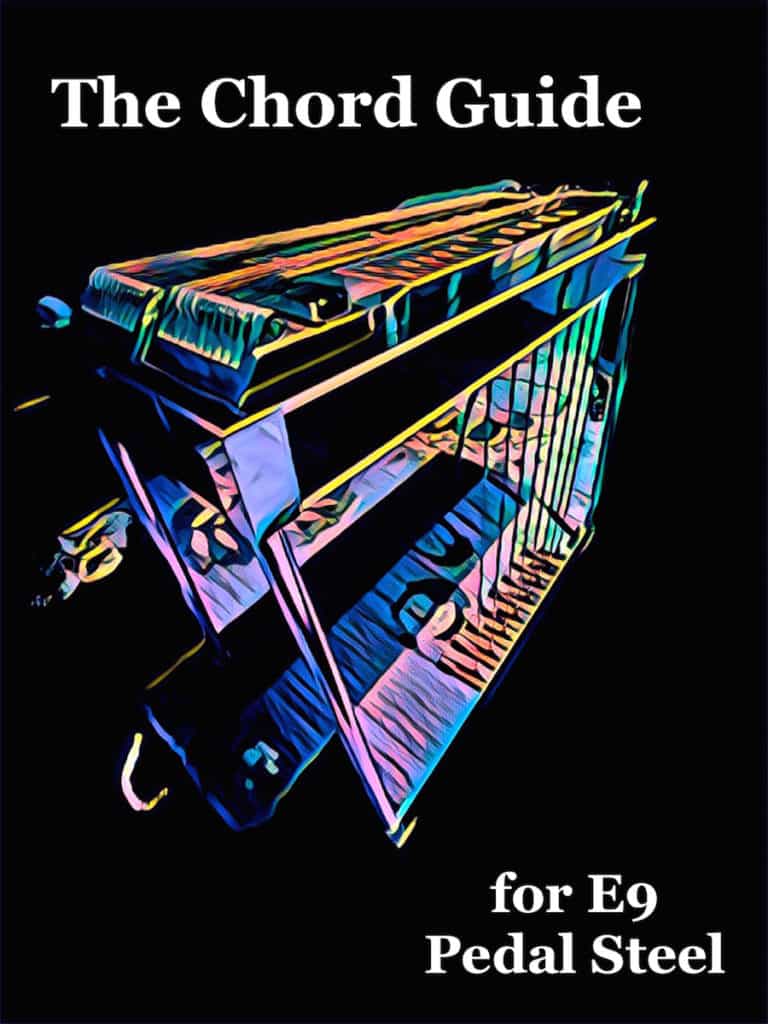
Learn the chords on the E9 neck in a way that makes playing simple and enjoyable…
- Almost Every Chord You’ll Ever Need for E9
- Intuitive and Easy to Use
- Make Use of Pedal and Lever Combinations
- Example Tabs of Chord Movements
- Easily Utilize the Nashville Number System
- Great For Any Key and Style of Music
Includes a bonus section of over a hundred pages of extra chord charts, key references, and more!
You may also like…
200 Country Riffs & Licks for E9 Pedal Steel
Add these country licks to your playing repertoire…
- Easy to Read Format
- Includes Rhythmic Notation
- Playing Over Chord Changes
- Great for Country, Alt-Country, & Honky-Tonk Styles
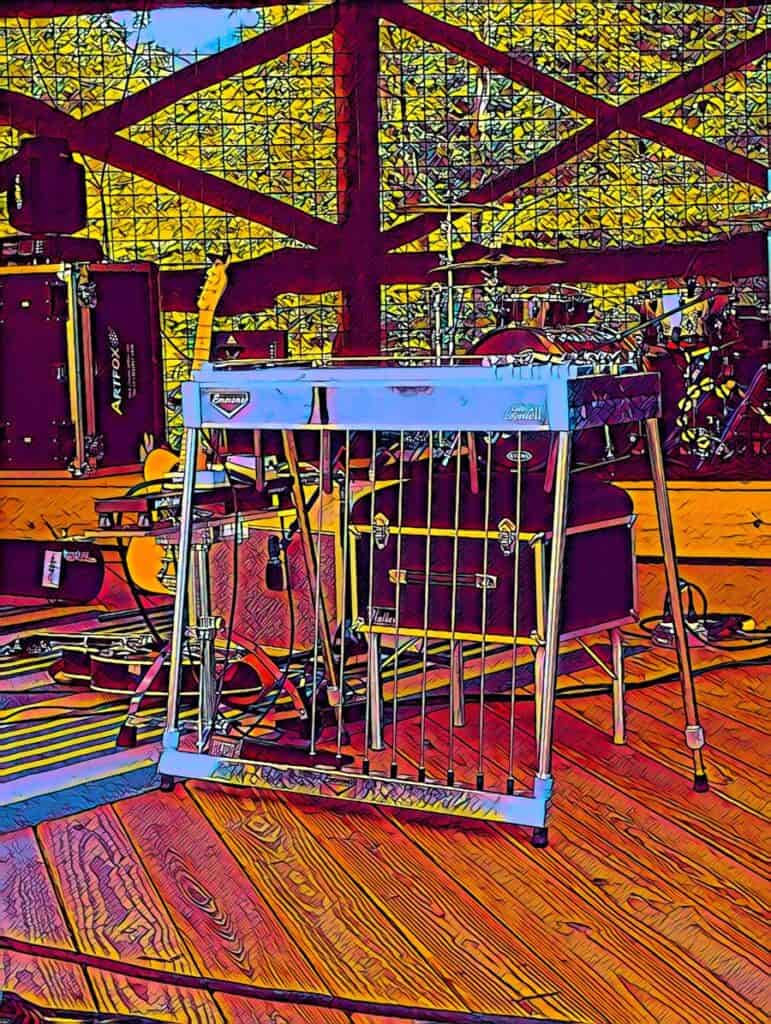

The Scale Book for E9 Pedal Steel
Over 1,000 Pages with Tabs and Diagrams!
- Easy to Use Reference for Practicing
- All Major and Minor Pentatonic Scales, Modes, Major Scales
- All Keys, and Covers the Fretboard
- Includes Pockets of Scales
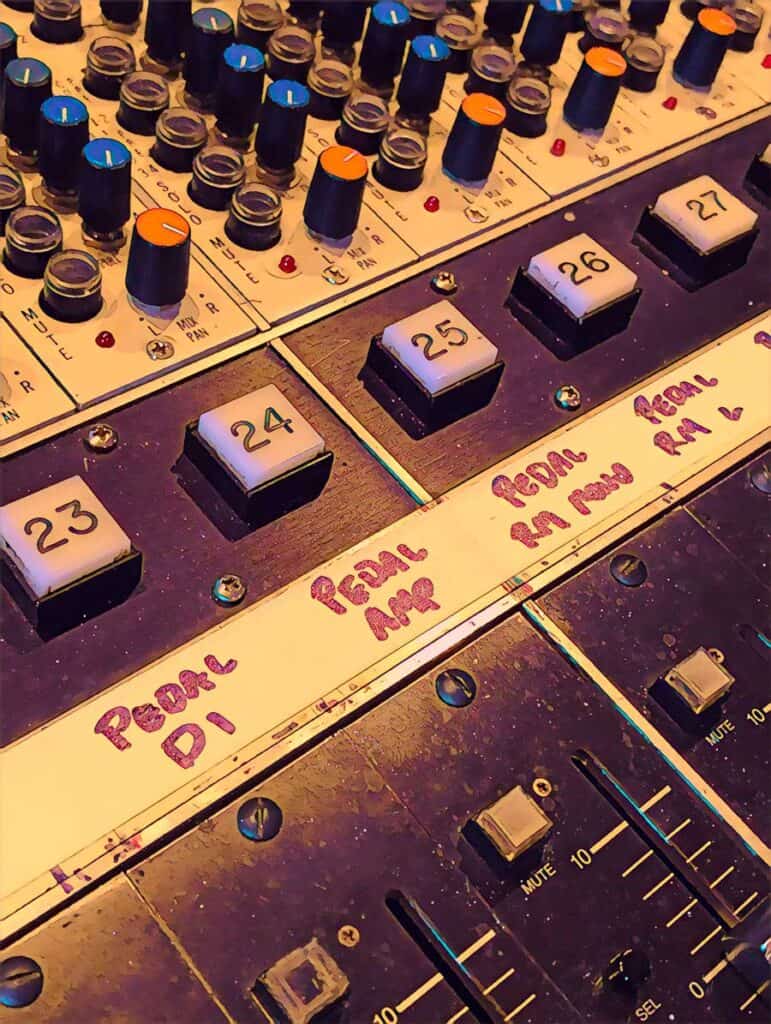
Harmonized 6ths
- Hundreds of Riffs, Licks, and More
- How To Play Sixth Intervals on the E9 Neck – Over Any Chord
- Utilizes The Pedals and Knee Levers

Right Hand Picking & Blocking
- An In-Depth Guide to Picking and Blocking
- Perfect Your Technique
- Includes Graphics, Illustrations, & Practice Exercises
